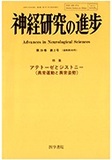Japanese
English
- 有料閲覧
- Abstract 文献概要
- 1ページ目 Look Inside
はじめに
アテトーゼとジストニーの定義や概念,異同や差異について多くの臨床家,研究者の間で必ずしも常に一致が見られるわけではない。また,アテトーゼとジストニーが共存することもある。同様なことはヒョレアとアテトーゼの間にもありヒョレオアテトーゼという現象も存在する。ここではこの問題に深入りせず,臨床的にこれらの不随意運動,異常姿勢を呈した自験例の病理像を中心に述べたい。
一般にアテトーゼ,ジストニーなどの病変主座として取り上げられるのは線条体,淡蒼球などの大脳基底核,ルイ体,視床,中脳黒質・赤核,小脳歯状核などである。これらの部位が単独で障害されるか,あるいは複数部位が関連するかの問題がある。
The neuropathological changes of the diseases, which clinically manifest chorea, athetosis and dystonia, are classified into the following subgroups: 1) Degeneration of caudate : The small cells in the caudate are predominantly affected. Choreic diseases, including Huntington disease, are categorized into this group. 2) Extended striatal degeneration: The caudate and putamen are similarily affected, and both large and small cells are depleted associated with massive fibrillary gliosis. Patients clinically show athetosis, dystonia and/or opisthotonus, and bilateral striatal necrosis belong to this group.

Copyright © 1995, Igaku-Shoin Ltd. All rights reserved.


